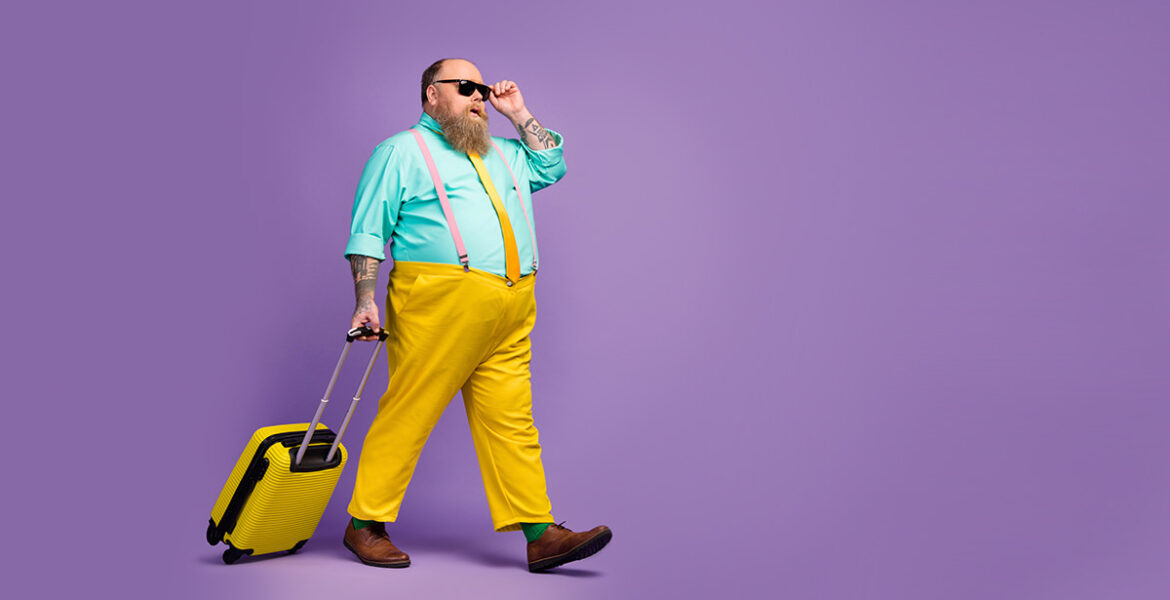

Fat people on planes can have rather unpleasant experiences. When overweight passengers need to fly, they come across a variety of obstacles: from plane design to fat-shaming. But do plus-size travelers really need to associate airlines with nightmares? Is it even possible to enjoy flying while fat?
To some extent, we can all agree that airline policies of packing passengers in planes like sardines in cans are not fair. The extra legroom seats are the most sought-after section of the plane, securing extra profit for companies. But we should all be assigned more than just minimal space when flying.
This guide to flying while fat will lift the weight off your shoulders
While we can relate to this basic idea of comfort in the air, public opinion easily shifts if the person demanding more personal space in planes is – overweight. Suddenly, once united protesters against the airline policies split off into groups. One of these certainly becomes an avid defender of the status quo. For them, the obese passengers on a plane should be stripped of their rights to demand a more comfortable flight.
Humans are complex beings, both physically and psychologically. But if you are overweight, you already know that you will typically be expected to offer a lot of explanations for your condition in order to be perceived seriously.
Hopefully, this comprehensive guide for fat people on planes will at least give you essential practical tips on flying while fat and advice on how to board your plane without the weight of worries.
As British blogger Kirsty Leanne found out, it doesn’t take much for large-bodied travelers to stir internet debates. The TikToker was flying with Ryanair and illustrated her uncomfortable experience of flying as a fat person in what became a viral video, with more mean than meaningful backlash.
“The first issue I faced was walking down the plane aisle. I felt the stares of people and all I could think was that they didn’t want me to sit next to them”, Kirsty revealed.
But gazes were not the only issue an obese person on a plane has to face. Narrow aisles, even narrower lavatories, and the use of seatbelt extenders, all of these affect the experience.
Kirsty’s belly got in the way of her wishful lunch break too. “The tray table was a big fat no”, she said, while trying to open it with no success.
The internet backfired with thousands of comments ridiculing Kirsty’s issues. The most frequent advice was aligned with the simplified school of thought such as “eat less”, “change your lifestyle”, “buy two seats”, “disabled people deserve more accessibility than you do”, “the world doesn’t revolve around you”, “I feel bad for the people sitting next to you”…
While the hate speech would affect many of us negatively, Kirsty simply tries to shake it off. She has dedicated her TikTok, Instagram, as well as Plus Size Travel Too blog to helping overweight people travel the world. Hashtags #bodyliberation and #fatacceptance support her mission, and doing it in public does take some personal toll.
In 2019, a business class passenger on a flight from Moscow to Vladivostok was two kilos heavier than the airline’s limit. His name was Viktor. With 10 kilograms of weight, this cat wasn’t fitting into Aeroflot‘s restrictions on pets flying inside the cabin.
To protect the feline from stress connected to flying in a cargo hold, Viktor’s owner Mikhail Galin came up with an ingenious plan. He borrowed a smaller lookalike cat called Fibi, and after the weighing at the check-in, he swapped the furry body double with a real travel companion that would join him on board.
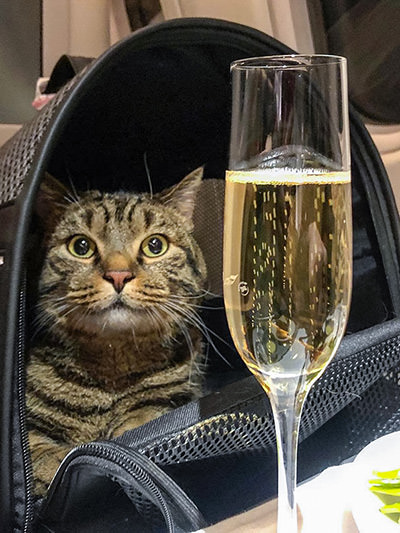
This trick could have gone unnoticed, but just like in Kirsty’s case, the social media posts brought attention to the story. Viktor’s moments of purring next to the glass of champagne were eternalized in Facebook and Instagram posts.
The airline launched an investigation on what they called a “serious violation”, and even found CCTV footage of the cat swap. Aeroflot kicked Mikhail out of their loyalty program and confiscated his air miles.
Unlike in Kirsty’s case, the general public was more sympathetic to the overweight passenger: “He deserves a medal! How ridiculous the cat has to weigh a certain amount”, “Can’t believe the airline is fat-shaming him”, “Aww so cute though it’s a violation”…
Cat lovers were rooting for public protests. Companies were offering free yearly supplies of cat food for Viktor. Mikhail was offered unlimited taxi rides. The Russian parliament member Vladimir Burmatov lobbied with the airline to revise its policy and return Mikhail’s nullified miles. The serious matter reached even Russian President Vladimir Putin, but he decided not to comment on the cat’s situation.
People can have different criteria when commenting on overweight passengers on flights. A few kilos here or there, is it really that important? Can a plane really be too heavy to fly?
The simple answer is: yes, the plane can be too heavy to fly. This is determined by laws, those we, the people, have written, but also those written by gravity.
There are quite a few elements affecting the plane’s performance that are beyond the control, such as the runway length, elevation and geomorphologic surroundings of the airport, and weather conditions (air temperature, wind).
On the other side, there are elements affecting the plane’s performance that we can control, such as the weight and its distribution in the aircraft (balance).
Overloaded planes, especially the smaller ones, are risking fatal accident scenarios.
To optimize flight operations, all planes have a maximum takeoff weight and a maximum landing weight. Those numbers are not the same, namely because of the fuel consumption during the flight.
If the flight becomes unexpectedly shorter or requires an emergency landing, the plane needs to lose some weight first. As throwing passengers and bags out of the plane is not an acceptable option, the only solution that remains is – the fuel dump. Despite widespread beliefs that this procedure is done to minimize the risk of an explosive impact, it is connected to controlling the maximum landing weight of the aircraft.
Our weight is a worldwide problem, but not equally dispersed. According to the available data, the most overweight countries are the islands in the Pacific such as Nauru, Palau, Cook Islands, Marshall Islands, and Tuvalu. In the United States, more than 70,2 % of the population is overweight or obese. In Europe, the countries with the most overweight citizens are Greece, Poland, the Czech Republic, Slovakia, and Iceland.
Since the 1980s, airline seats have been constantly shrinking, yet passengers have been getting bigger and bigger. While bags could be weighed before the flight, the weight of the passengers is generally averaged and estimated. Different regulators recommend different figures.
The Federal Aviation Administration in the USA estimates the average male passenger’s weight at 90.7 kg in summer and 93 kg in winter. Female passengers are averaged at 81,2 kg in summer, and 83,5 kg in winter. Children weigh 37,2 kg in summer, and 39,5 kg in winter. These figures include hand luggage.
The European Aviation Safety Agency estimates that men weigh 84,6 kg, women 66,6 kg, and children 30,7 kg.
To extend the safety margin, the Civil Aviation Safety Authority in Australia has a sliding scale, depending on the size of the aircraft. Passengers’s weight is estimated at 86 kg (male) and 71 kg (female) on smaller planes, down to 81.8 kg (male) and 66.7 kg (female) on larger ones.
Tui miscalculation In 2020, the Tui airline's new software update resulted in a possibly dangerous miscalculation. On a flight from Birmingham to Majorca, 38 passengers identified as Miss instead of Mrs, and the reservation system assigned them the child's weight. The actual weight of the aircraft was thus more than a tonne heavier than what the figures were showing. Luckily, the flight operation was safe in the end, and the software was soon amended.
Airlines should weigh a sample of their passengers every 3 to 5 years, to keep the figures updated. While airlines can indeed ask passengers about their weight, participation in these surveys is normally voluntary.
However, there are remote regions of the world where weighing passengers by airlines is a common practice. Such is the case with smaller aircraft in some destinations in Australia, where one could be asked to be weighed before boarding.
In Samoa, one of the world’s most obese countries, a short-lived operator Samoa Air introduced a pay-as-you-weigh system in 2013, describing it as the concept of the future. “A kilo is a kilo is a kilo”, explained the CEO Chris Langton. The flight rates ranged from 1 to 4.16 dollars per kilogram (for a passenger + bag combo), and the idea was promoted as the fairest way of traveling.
In 2016, Hawaiian Airlines also noticed that their flights to American Samoa are often overweight. This airline started weighing their passengers regularly, but only for the reasons of even weight distribution in the cabin.
“Am I too fat to fly?”, you wonder. Even though there are no weight limits for fat people on planes, there are normally three basic requirements for flying while plus size:
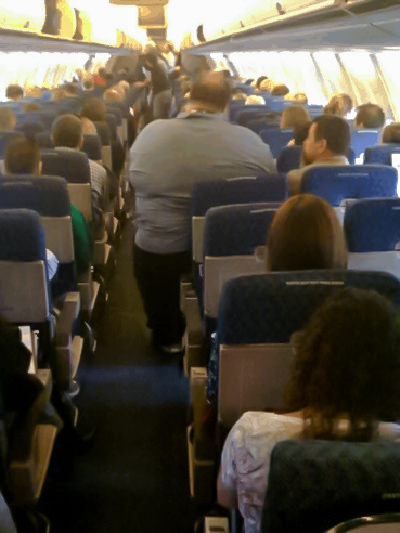
If the passenger cannot comply with the above-mentioned requirements for a comfortable flight, he or she will be offered to purchase an additional seat. Typically, the second seat could be bought at a discount, and in the case that the flight is not full, the purchase could be eligible for a full refund.
If there are no additional seats available on a particular flight, the passenger who is too fat to fit in the airplane seat comfortably will have to deboard and reschedule their flight.
How do you know if you will be too fat for a plane seat? There are two elements you could check beforehand: the airline seat width and the seatbelt size.
From 48 cm (19 inches) in 1985, the width of the plane seats has shrunk to as low as 41 cm (16.1 inches). As the situation differs from airline to airline, aircraft to aircraft, and even a section of the aircraft to a section of the aircraft, it is best to check out the exact seat width on a flight you are looking to book on SeatGuru‘s maps.
As for the seatbelt size, it typically ranges from 100 cm (39 inches) on Southwest Airlines to 130 cm (51 inches) on Hawaiian Airlines. A seatbelt extender will normally add 64 extra centimeters (25 inches).
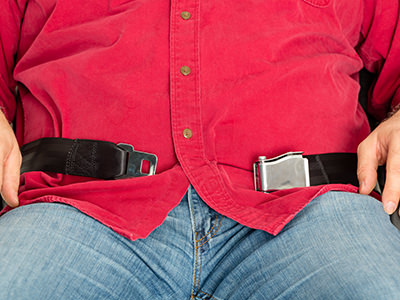
As if flying while fat doesn’t draw enough attention by itself, there is often a notion of embarrassment and humiliation connected to the fact that fat people on airplanes need to ask for seatbelt extenders.
Some passengers of size even end up avoiding the feeling of shame by trying to pretend they are all buckled up. This is certainly not recommendable as seatbelts are essential safety devices in the case of an emergency.
The way to minimize the stress is to try to board before others and request the seatbelt extender as soon as you enter the airplane, or sit in the aisle seat so you can discreetly signal or whisper your needs to the flight attendant. They are distributing the seatbelt extenders on every flight, so you should really not approach it as a big deal.
If you want to avoid the conversations on airplane seatbelt extenders altogether, an option is indeed to purchase your own. Check out this affordable universal seatbelt extender for your next plane journey!
What is the best seat on a plane for a fat person?
Intuitively, passengers of size might reach for extra legroom seats, but that is not always the smartest choice. For instance, the armrests could be fixed making the seat even narrower, and you will not be allowed to wear a seatbelt extender in the emergency exit row. A bulkhead seat could come with a set of similar limitations. Sitting in the back of the plane is also not ideal as the last row seats do not recline.
If you are a person of size, always consult the plane map before picking your seat. Aim for the middle of the cabin, closer to the wings, where turbulences are more bearable. According to your preferences, you might choose to sit closer to the galley, if you think you would need assistance often, or closer to the bathrooms, in case that’s where you would gravitate.
When a row has three seats, never choose the middle one! If you can control your bladder, opt for a window seat. If you think you will have to get out of your seat often, pick the aisle seat. But keep in mind that sitting in the aisle seat means you will be getting up for your fellow passengers too, whenever they feel the urge to go to the bathroom.
These days, anyone using the plane lavatory needs to have some basic contortionist skills. While aiming to squeeze even more human sardines into the plane, airlines have shrunk the plane bathrooms too. Currently, the smallest loos are 61 cm wide (24 inches).
To not rely on circus techniques when you need to go, you can ask flight attendants for a wheelchair-accessible bathroom, or alternatively for mercy to let you visit the first class.
Hear real experiences of overweight passengers in “Flying While Fat”, a short documentary animation by British fat activist and artist Stacy Bias!
Different airlines handle plus-size passengers differently. So which ones provide more comfort? What are the best airlines for overweight passengers?
Air Canada could give you more than 51 cm wide seats (20.2 inches). But even if you have to sit in those that are 43 cm wide (17 inches), the good news is that Air Canada gives its plus-size passengers a free extra seat on domestic flights, as long as they bring the doctor’s notice. Air Canada’s obese passenger policy is aligned with the government’s policy classifying obesity as a disability.
Among other fat-friendly airlines in the world, we could include Japan Airlines, Bangkok Airways, China Southern Airlines, Singapore Airlines, Uzbekistan Airways, and Emirates.
What about the plus-size-friendly airlines in the United States? JetBlue welcomes overweight passengers in seats that are at least 46 cm wide (18 inches), Delta Airlines gives at least 45 cm (17.9 inches), while low-cost Spirit Airlines offers ‘Big Front Seats’ that are 51 cm (20 inches) wide.
Whichever seat or airline you end up choosing, you will find the cheapest flights on this link! During the Black Friday promotion, get a special discount if booking before December 5th, with the promo code "BFRIDAY40"!
When we fly, we cannot always choose all aspects of our experience, simply because we need to get from point A to point B at a certain time. Still, there are ways that obese people on planes can improve their experience of flying. These plus-size flying tips and hacks will help you prepare for the stressless journey!
If you choose to fly in off-peak hours or low season to your destination, there might be a greater chance of finding empty plane seats you could stretch over. These could be the earliest flights in the day, or generally the shoulder season at your destination of choice when the weather is still fine, but the touristic pressure vanishes. Your wallet will love you too.
Join the airline’s loyalty program. As you will be traveling more and more, the accumulated award points or miles could come in handy when you want to upgrade your seat to business class, where seats are considerably more comfortable.
If you cannot afford a higher booking class than the economy, an aisle seat is usually the best pick for passengers of size. It will provide you with more comfort as you will be able to get up and stretch as you like, without crawling over fellow seatmates. If the flight is short enough that you feel you won’t need to get up as often, you could consider booking the window seat.
Traveling in the company of a friend, a family member or a partner will make it significantly easier for you. You will avoid the situations with annoyed passengers you rubbed your shoulder with, and generally have moral support in potentially stressful moments.
To avoid unpleasant security check issues, try to dress simply, with no metal parts that could trigger additional security checks. Wear shoes you can easily take off and put back on, and loose clothes you feel most comfortable in.
Kindly approach the gate agent while waiting for the flight, and ask if it’s possible to check the situation with the seating. You might just be able to get reseated to a row with fewer passengers.
Airport restrooms are much spacier than those on the plane. Using them might help you skip the entire experience of trying to squeeze yourself into the plane lavatory.
In a narrow aisle, crowded with people looking for their seats and place to store their carry-on, overweight passengers might struggle to navigate. That’s why you should board as soon as the gate opens, and find your seat with no pressure.
Pre-boarding also allows you to ask flight attendants for a seatbelt extender without large social pressure around you. Alternatively, purchase your own.
If it feels crowded in your row, discretely ask the flight attendant’s assistance in finding you a potentially roomier area. Sitting next to a skinny person or a child will put you in a more relaxed state of mind than constantly thinking about how to scrunch up yourself smaller and non-obstructive.
Put a smile on, say ‘hi’, and introduce yourself to the passengers you will be sharing the row with. It might not be the start of a friendship, but being kind at the beginning might set the tone of the entire experience differently.
If your luggage gets lost or delayed, your airline or insurance company could reimburse you for buying the necessary clothes. However, for larger passengers, it might be difficult to find an adequate clothing size at the destination. That’s why you should try to travel with a carry-on, or at least always have some clothes of your size easily accessible.
You want to avoid the situation of ordering a meal on the plane only to find out that you are too fat for an airplane tray table. To avoid the situation where your body obstructs the opening of the tray table, bring your own sandwiches and snacks instead, and eat them at your leisure.
Just because you think you might cause inconvenience for others, that doesn’t mean you should ignore your need for moving. It is good to get up from your seat every two hours, stretch your legs, rotate your ankles, flex your toes, and have a walk. That’s the best way to avoid the risk of deep vein thrombosis, a serious jeopardy for obese airline passengers.
Put on your best puppy eyes and politely ask the flight attendant if it would be possible to use the bathroom in the first class. That one is typically more spacious than those squeezed in the coach section, and with a steward full of understanding, you might unexpectedly upgrade your toilet visit experience.
If one is overweight, it doesn’t mean he or she should settle for a sedentary lifestyle. People of size also want to travel, but the travel industry is rarely designed to accommodate them.
This doesn’t mean that the urge for traveling among the large-bodied passengers is dying down. In 11 years, nearly 22,000 people joined the Facebook community for fat passengers. In 2015, a subgroup for superfat passengers had to be formed, with 2.400 members now.
Why do airlines insist on humiliating the largest among us with toilets the size of their shirt?
World statistics tell us that overweight people have become a dominant group in certain societies. Instead of accommodating the growing market in the last four decades, airlines were doing exactly the opposite: shrinking the plane seats, and trying to raise their profits at the cost of passengers’ comfort. But people who should travel in those smaller seats are actually growing.
Should obese passengers go on a plane with a feeling of guilt, or should the regulators rethink the norms that were formed in the past?
There is no passenger weight limit that would rule out a fat person from flying on a plane. So why do airlines insist on humiliating the largest among us with toilets the size of their shirt or seatbelts the size of their necklace?
Indeed, for plus-size people sometimes it is easier to just give up and admit that they are “too fat to fly”.
Labels are blooming in our society, but maybe using the transport to get from one point to another should be exempt from them.
Airline obesity policies are sometimes merely a marketing stunt. But the market is changing, and it is not enough to use the buzzwords to draw people’s attention anymore. The public expects airlines to accommodate a variety of travelers, from chubby flyers to those who manage to squeeze in the current seat configurations more easily. We all deserve enough space when traveling.
Did you have an experience of flying while fat? If you want to share the experience of fat people on planes, please leave a comment below!
If you liked this article on fat flying, pin it for later!
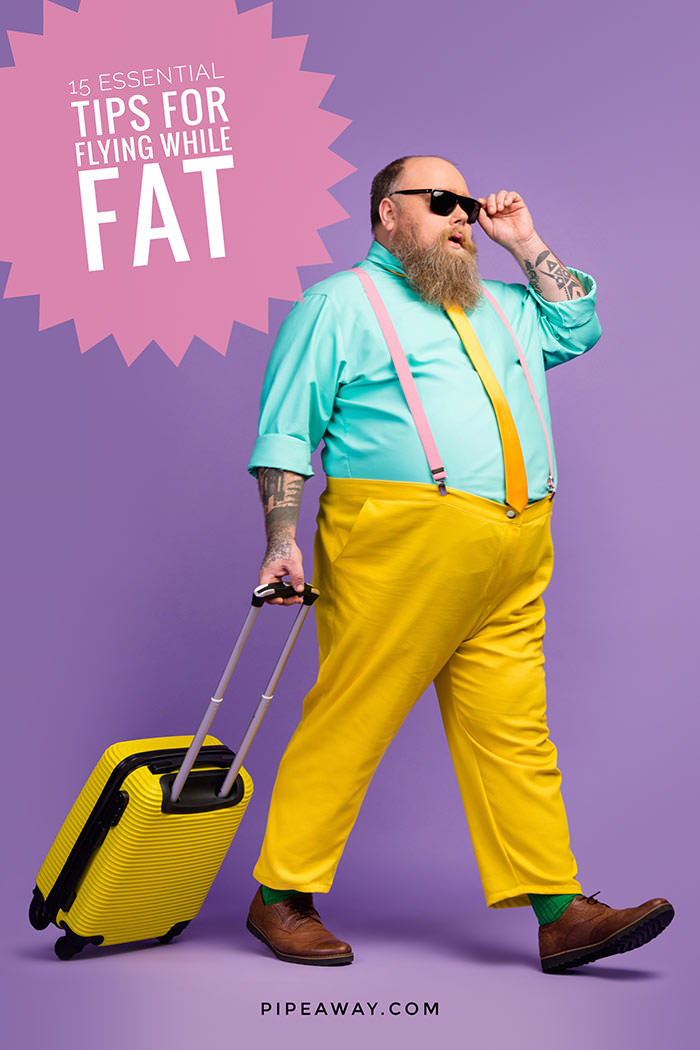
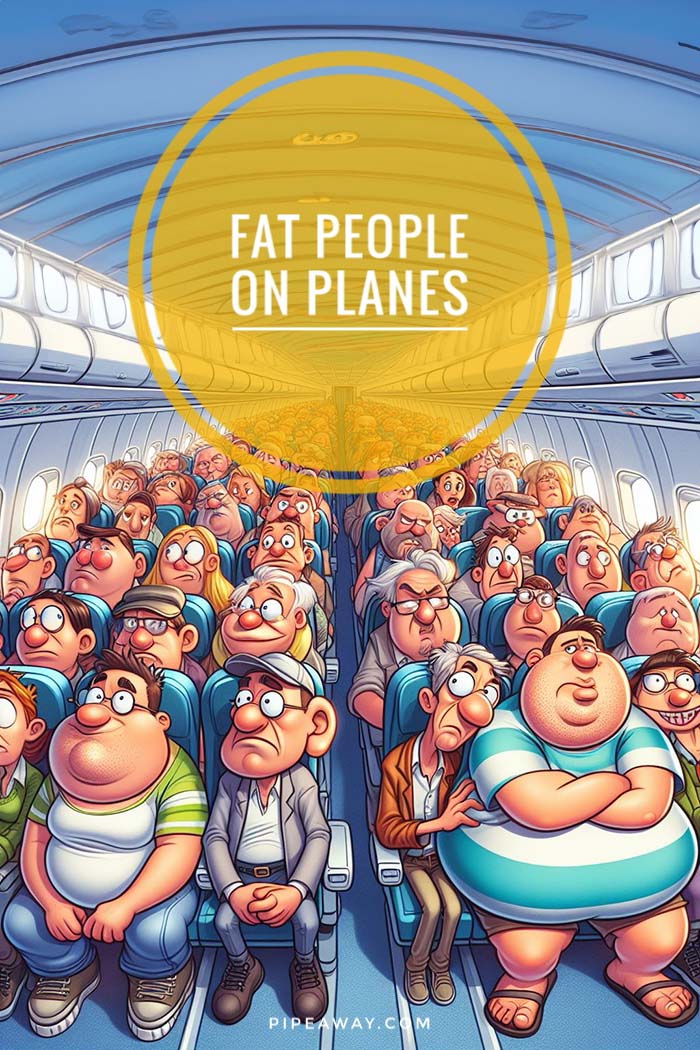
This post was originally published on May 17th, 2022, and was updated on November 7th, 2023.
Disclosure: This post may contain affiliate links, which means if you click on them and make a purchase, Pipeaway might make a small commission, at no additional cost to you. Thank you for supporting our work! The cover image of this article was purchased through Depositphotos, my go-to platform for high-quality licensed stock images. They have great photo deals, so check them out!Tags: flying, plane
Award-winning journalist and editor from Croatia
22 Ivan Kralj May 17, 2022
Jamil Dybwad says:How are people travelling if they weigh more than severely obese, say 200kg? How do the toilets work for disabled, is there room for a 2nd person in the toilet? How simple is it to buy a ticket for a person with special needs, not to be thrown off a plane?
Ivan Kralj says:Hi, Jamil!
These particular questions could have different answers at different airlines.
The best would be to reach out to the company that a severely obese/disabled person intends to travel with, and get a concrete answer about all the flight elements.
Good luck!
Ivan
Seat belt lengths vary so widely. In some planes they are more than big enough in others, the are too short. I am going to buy the extender. I never thought to get them on Amazon. Thanks for the link.
Ivan Kralj says:Yes, indeed, Amy, it seems that preparing for a flight these days includes an excessive amount of googling and researching the subject. Airlines are different, even planes under the same airline brand are different. Not knowing what we buy in the end, could be quite frustrating.
I’m glad that the seat belt extender link on Amazon helped. Safe travels!
Purchasing an extra seat at a steeply discounted price is an excellent compromise, IMHO. Air travel is tough enough already, no matter what your size. Let’s make it as comfortable as reasonably possible for everyone.
Ivan Kralj says:I agree that the discussion on fat-friendly airlines should actually transform into a discussion on human-friendly airlines. We all deserve both comfort and safety when traveling.
Darla says:Thanks for this thoughtful treatment of what it’s like to fly as an overweight person. Some of these details shocked me, and I’m resolved to be extra kind to all passengers on my upcoming flights.
Ivan Kralj says:Thanks for your thoughtful comment, Darla!
Traveling experiences are not the same for everyone, and indeed plus-size travel is not the hottest media topic.
This might be an exact reason for a lack of the general public’s sensibility on issues overweight passengers experience.
I’m glad if this article contributes to a deeper understanding of the matter!
Such an interesting article and helpful tips. As a plus-sized traveler myself, I definitely have felt the stares of other passengers like Kristy had and it makes an already uncomfortable situation even more so. Thanks for sharing your tips. I will use them next time I fly!
Ivan Kralj says:Thanks for your comment, Maria!
I am glad that you found the tips for overweight travelers useful.
I hope they will raise the comfort level of your next trip! Enjoy your travels!
This is a hard, but good conversation. I’ve flown next to obese people on several flights. On one flight, the passenger kept moving the arm rest up between us and I’d find myself pushed into the other armrest and her partially in my seat. It was a constant battle of the arm rest (we didn’t speak the same language). For long flights, it can be hard on everyone!
Ivan Kralj says:I hear your point. Exactly, we are all in the same boat (plane), so airlines should aim to find solutions that all their users could benefit from. For a start, I believe it’s about not squeezing us all in like sardines, no matter what our size is.
Fat Flyer says:Buying an extra seat is not a good option unfortunately. A majority of planes are overbooked and attendants are within their rights to “give away” the seat you have paid for and seat a passenger there. I have had this occur myself.
Ivan Kralj says:Airlines’ policy of overbooking flights is certainly an issue.
Can you share if you got reimbursed for losing the seats you paid for?
Had any compensation for accommodating another passenger?
Your suggestion to be relocated to a seat next to a small person or a child means your strategy is to find small passengers so you can encroach on their seat space. And you wonder why people are hostile to morbidly obese travelers? Buy the second seat.
Ivan Kralj says:Hi, Mercy!
Nice name.
Sorry, I couldn’t resist. But sometimes, humor can soften up our automatic hostile responses. Hopefully.
As for myself, I am not a “morbidly obese traveler”, so while I understand the point you were trying to make, don’t hold this against the fat people on planes – they were not the ones writing these fat travel tips!
I assume you were referring to tip number 10, in the entire list of tips on how plus-size passengers could handle their flying experience more comfortably.
But no, this tip was certainly not instructing any obese flyer to encroach on anyone’s seat space.
I believe these people are most often aware of their size, and the tip you were referring to was trying to instigate some peace of mind during their travel hours, not a physical invasion into other seats.
As you correctly conclude – people become hostile due to their experiences.
So if plus size passengers have the option to choose between sitting next to a hostile person, or next to a person that potentially might not have an objection, or even experience any negativity during the flight, I see no problem in their intention to try not to spoil anyone’s trip.
Then again, we come to the conclusion that this problem exists only because this is how the airlines organize the plane space.
For instance, why do three seats have four armrests in total, if three people have six arms? So who should own which armrest?
You see, the edge of each passenger’s personal space in this type of planes is always a result of some unwritten human agreement.
The best way to advocate against hostility would maybe be to approach the real flight designer and demand we all get treated as humans, not bags of potatoes.
This is ridiculous. Simply because an obese person’s feelings will be hurt, you’ll make the people sitting beside them uncomfortable because they’re squished. Obese people should have to buy two tickets, and claiming it takes away their rights is unreasonable.
Ivan Kralj says:Dear Taylor,
Thank you for sharing your perspective on the topic. Your concerns regarding the comfort of other passengers when seated next to someone who requires extra space due to their size, are understandable. It’s important to acknowledge that different people have different opinions on this matter.
Airline policies regarding plus-size passengers vary, and there are different approaches to addressing this issue. Some airlines do require individuals who cannot fit comfortably within a single seat to purchase an additional ticket. This policy aims to ensure the comfort and safety of all passengers on the flight.
On the other hand, advocating for the rights and dignity of all individuals, regardless of their size, is also an important aspect to consider. It’s a delicate balance between accommodating passengers’ needs and respecting their rights.
The goal is to find a solution that promotes inclusivity and ensures a positive travel experience for everyone involved. Airlines and passengers alike should be working towards finding the right balance through open dialogue and understanding.
Ultimately, as article points out, we should all be entitled to more space when flying, and demand that airlines stop shrinking passengers’ space. We should not finance the airlines’ extra profits by turning against each other.
Thank you for sharing your thoughts on the matter, as it’s crucial to have conversations that consider different viewpoints and seek solutions that can benefit everyone involved.
I’ve been sat on during several flights. The worst was the guy who was wearing shorts and put himself in the middle between me and his kid. I threw up after we landed when I went to the bathroom and saw that this random guy’s sweat had soaked through my jeans and onto my leg right where his body was on top of mine. If you can’t fit in one seat, the airline should require you to buy two and ensure that the second seat is not given away and is kept between you and the other passengers in the row. I shouldn’t have to put up with a stranger sitting on me when I am fully within my seat and I shouldn’t have to embarrass someone by talking to a flight attendant to avoid getting a stranger’s bodily fluids on me. Just because they can buckle the seatbelt with an extender and have the armrests down doesn’t mean they fit. The flight attendants noticed but didn’t say anything about how he was still spilling over and under it and onto my leg and couldn’t put his feet in front of his own seat instead of putting one foot on top of my bag with significant pressure. If you take up more room than one seat provides, you need to plan for that and airlines need to do better at not reassigning seats and being honest when someone needs two seats but only bought one.
Ivan Kralj says:Thanks for sharing your experience, Violet!
I’m sorry to hear it was not a pleasant one.
Indeed, airlines should do more to guarantee everyone’s comfort AND safety on flight.
I can imagine that, in the event of evacuation, it would be hard to provide safe escape route with such seat design and policy of seat assignment.
Thank you for raising your voice in painting the picture of the issue which is obviously not being addressed enough by airlines that, on contrary, try to sell as many seats as possible, at the expense of mentioned passengers’ comfort and safety.
I’m getting ready to fly to attend a family wedding and unfortunately it’s too distant for car travel. I’m so scared because I’m not sure what I’m up against in fitting the airline seat… hearing that airlines have narrowed the seats and I have gained weight over the past 8 years since last flying I’m stressed! I don’t have the money to buy an additional seat for 6 flights… and I shouldn’t have to frankly. Why don’t airlines accommodate their passengers? Why can’t they make several rows have 2 seats (1+1/2 seat x 2) and make the price 1+1/2 so that they get the full fare whether 2 or 3 seats in that row but it provides options for heavier travelers? (I would be glad to purchase this type of larger seat to guarantee enough room and not impose on others, but not to have to pay double!) Or why don’t they make the seat rows angle like a “V” so the 3 seats (aisle vs middle vs window) are all staggered maybe 4″ in front of each other which would help someone not touch you and give someone a bit more arm room… Heck these design people can’t even design a decent public restroom stall. I DO understand that normal size people are intruded upon and it grosses them out because I felt that way myself back then, but I have a thyroid problem so it’s not that I just sit and eat cake all day long! I also broke my ankle and that had me sedentary for 6 months. I now realize how naive thin/regular weight people are about the issues of why some of us are fat and that it’s not from being lazy, sedentary or gluttons! Family genetics and pharmaceuticals impact weight. There has got to be a better solution and I put that burden on the airlines!! But please don’t shame anyone or expect them to suffer just because – do you really think we enjoy the excess weight and discrimination? I ask you to look around at society and how I would guess ~50% are heavy and/or obese… I truly don’t want to impose my fat on anyone… but I do have to travel! I don’t think I’m too fat to fly but I’ll find out how this trip goes… I recall a person sat next to me once and announced they had PTSD and I simply said, “OK, let me know if you need anything” – I just hope my seat mates will give me the same courtesy – I will ensure I do everything to keep them free of me that I can.
Ivan Kralj says:Hi Susan, Thank you for sharing your thoughts and concerns about flying as a plus-size traveler. You’re absolutely right; airlines should strive to be more accommodating to passengers of all sizes. Your idea of rows with larger seats at a reasonable price is innovative and could greatly improve the flying experience for everyone.
I could only assume that, for airlines, it would not be attractive as selling those seats as higher class would. Obviously, with some shifts in design and upgraded meals and service, they can easily earn more on those if they call them business class or first class seats. Thank you for shedding light on the complex factors that contribute to weight-related issues. Your perspective on genetics and pharmaceuticals is a crucial reminder that weight is a multifaceted issue, and no one should be shamed or discriminated against because of it. Your commitment to being considerate of your seatmates is commendable! We should all be more thoughtful when traveling with others. I hope your upcoming trip goes smoothly, and I share your hope that airlines will continue working towards making air travel accessible and comfortable for passengers of all sizes. Safe travels and enjoy the family wedding! ✈️🎉